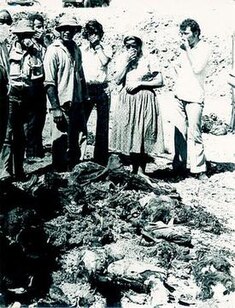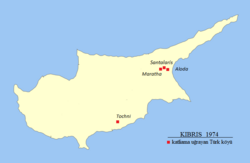Maratha, Santalaris and Aloda massacre
| Maratha, Santalaris and Aloda massacre | |
|---|---|
| Part of atrocities against Turkish Cypriots during the Turkish invasion of Cyprus | |
 Dead bodies of Turkish Cypriot civilians at Sandallar (Santalaris). | |
 Locations of massacres against Turkish Cypriots in 1974 | |
| Location | Maratha, Santalaris, Aloda in Cyprus |
| Date | 14 August 1974 |
| Target | Turkish Cypriot civilians |
| Weapons | Machine guns, sharp tools |
| Deaths | 126 |
| Perpetrator | EOKA B |
Maratha, Santalaris and Aloda massacre (Template:Lang-tr) refers to the massacre[1][2][3][4][5] of Turkish Cypriots by EOKA B[4] on 14 August 1974[6] during the Turkish invasion of Cyprus in the villages of Maratha, Santalaris and Aloda. 89 (or 84[7]) people from Maratha and Santalaris were killed, and a further 37 people were killed in the village of Aloda.[8] In total, 126[9] people were killed during the massacre.[6]
Background
According to the 1960 census, the inhabitants of the three villages were entirely Turkish Cypriots.[10] The total population of Maratha and Santalaris was 207.[11] By 1973, the total population of the villages had risen to 270, with 124 in Maratha, 100 in Santalaris and 46 in Aloda. However, in July 1974, following the first Turkish invasion of Cyprus, all men of fighting age were taken away as prisoners of war to internment camps in Famagusta and from there transferred to Limassol.[12][13]
Massacre
On 20 July 1974, the men of the villages were arrested by EOKA-B and sent to Limassol. Following this, according to testimonials cited by Sevgül Uludağ, EOKA-B men from the neighboring village of Peristeronopigi came, got drunk in the camp they established in the village coffeehouse, fired shots in the air, and subsequently raped many women and young girls. The rape later included the boys and this continued till 14 August 1974. Upon the launch of the second invasion of the Turkish Army, they decided not to leave behind any witnesses and killed the entire population of the villages present at the time.[14][15]
In Maratha and Santalaris, 84-89 were killed. The imam of Maratha stated that there were 90 people in the village prior to the massacre, and only six people were left.[16] Elderly people and children were also killed during the massacre.[7] Only three people were able to escape from the massacre in Aloda.[1] The inhabitants of the three villages were buried in mass graves with a bulldozer. The villagers of Maratha and Santalaris were buried in the same grave.[1]
Associated Press described the corpses as "so battered and decomposed that they crumbled to pieces when soldiers lifted them from the garbage with shovels".[16] Milliyet reported that parts of the bodies had been chopped off and sharp tools, as well as machine guns had been used in the massacre.[17]
According to Greek Cypriot writer and researcher Tony Angastiniotis, at least one of the attackers used a mainland Greek accent, which suggested that he was a Greek officer.[18]
Reactions
The United Nations described the massacre as a crime against humanity, by saying "constituting a further crime against humanity committed by the Greek and Greek Cypriot gunmen."[19] The massacre was reported by international media, including The Guardian and The Times.[20]
Rauf Denktaş put off a meeting with Greek Cypriots after the mass grave was uncovered.[21]
See also
References
- ^ a b c Oberling, Pierre. The road to Bellapais: the Turkish Cypriot exodus to northern Cyprus (1982), Social Science Monographs, p. 185
- ^ L'Événement du jeudi, Issues 543-547 (1995), S.A. L'Evénement du jeudi, p. 45 Template:Fr icon
- ^ Documents officiels, United Nations: "Only three of the inhabitants of Atlilar (Aloa) survived this massacre. For the defenceless inhabitants of the villages of Murataga (Maratha) and Sandallar (Sandallaris)..."
- ^ a b Paul Sant Cassia, Bodies of Evidence: Burial, Memory, and the Recovery of Missing Persons in Cyprus, Berghahn Books, 2007, ISBN 978-1-84545-228-5, p. 237.
- ^ Gilles de Rapper, Pierre Sintès. Nommer et classer dans les Balkans (2008), French School of Athens, p.263: "le massacre des villages turcs de Tochni (entre Larnaka et Limassol), Maratha, Santalaris et Aloda"
- ^ a b "Muratağa and Sandallar problem is being taken to the European Court of Human Rights" (in Turkish). BRT - Kıbrıs Postası. Retrieved 18 January 2011.
- ^ a b "CYPRUS: Ankara's Slow Nibble". Time. 16 September 1974. Retrieved 19 January 2011.
- ^ Paul Sant Cassia, Bodies of Evidence: Burial, Memory, and the Recovery of Missing Persons in Cyprus, Berghahn Books, 2007, ISBN 978-1-84545-228-5, p. 69.
- ^ List of Turkish Cypriot missing persons (Ministry of Foreign Affairs of the Republic of Cyprus) Retrieved on July 18, 2011.
- ^ Map of Cyprus
- ^ ΚΥΠΡΟΣ - CYPRUS (612 villages, 9251,47 Km²)
- ^ "Famagusta". PRIO Cyprus Center. Retrieved 3 April 2015.
- ^ "Aloa". PRIO Cyprus Center. Retrieved 3 April 2015.
- ^ Uludağ, Sevgül (13 July 2014). "From Maratha to Voni: Rapes as a weapon of war…". Politis. Retrieved 23 April 2015.
- ^ Uludağ, Sevgül. "The story of Assia (Pasakoy) and Afanya (Gazikoy)". Hamamböcüleri Journal. Retrieved 23 April 2015.
- ^ a b https://news.google.com/newspapers?nid=861&dat=19740903&id=r2AdAAAAIBAJ&sjid=VlsEAAAAIBAJ&pg=3020,430189
- ^ "İkinci Katliam", Milliyet, 2 September 1974, p. 10.
- ^ Asmussen, Jan. Cyprus at war: diplomacy and conflict during the 1974 crisis (2008), I.B. Tauris, p. 349: "Angastiniotis relates that at least one of the attackers had spoken with a mainland Greek accent suggesting that he had been a junior mainland officer."
- ^ UN monthly chronicle, Volume 11 (1974), United Nations, Office of Public Information, p. 98
- ^ Clement Henry Dodd, The political, social and economic development of Northern Cyprus (1993), Eothen Press, p. 101
- ^ "Turkish Cypriote Puts Off Meeting With Ethnic Greeks; American Heads Vatican Study". The New York Times. 3 September 1974.
